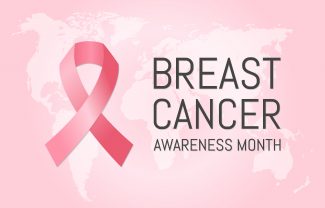
October is designated as Breast Cancer Awareness Month in countries around the world, aimed at increasing attention and support for early detection and treatments of breast cancer. Breast cancer is the most common type of cancer in women worldwide, in both developed and developing countries. It is estimated that 1 in 8 women will be diagnosed with breast cancer in her lifetime.
The Importance of Early Detection
The importance of early detection cannot be overstated as early detection greatly increases a woman’s chances of survival. Breast cancer cannot be prevented, although you can take steps to detect breast cancer earlier with self-breast exams and diagnostic testing such as mammography and MRI. Self-exams help women to know what their breasts normally feel like to them, so that any changes can be quickly reported to their physician.
Learn more about Breast Cancer Risk Factors, Screening Recommendations, and More including how to understand your BI-RADS assessment.
Stages of Breast Cancer
When a person is diagnosed with breast cancer, further testing will be completed to see if the cancer cells have spread within the breast area or to other areas of the body. This is called staging to determine the stage of the disease which is important to develop a treatment plan.
The different stages of breast cancer are:
- Stages 0 & 1 – Stage 0 is carcinoma “in situ”, which means the cancer is in the original place. There are 3 types of breast cancer in situ:
- DCIS – Ductal carcinoma in situ – non-invasive abnormal cells are found in the breast milk duct lining and has not spread. This is highly treatable when found early, left untreated it may spread to surrounding breast tissue.
- LCIS – Lobular carcinoma in situ – stage 0 lobular carcinoma describes abnormal cell growth forming in the lobules, although this type of carcinoma is non-invasive and often not considered cancer. LCIS is often referred to as lobular neoplasia as a more accurate description.
- Paget disease of the nipple – an uncommon type of cancer that has an outward appearance of eczema in the nipple area of the breast.
- Stage 1A and 1B – stage 1 breast cancer is further divided into two categories determined by the size of the tumor and if lymph nodes show evidence of cancer.
- Stage 2 – breast cancer is growing although it is still contained within the breast, or the growth has extended only to nearby lymph nodes. Stage 2 breast cancer is also divided into 2 categories, 2A, and 2B, with the difference being the size of the tumor and whether it has spread to lymph nodes.
- Stage 3 – breast cancer has spread beyond the tumor’s immediate region and has invaded nearby lymph nodes and muscles but has not spread to distant organs. Stage 3 breast cancer is considered an advanced stage although effective treatment options are increasing. Stage 3 is further divided into 3 stages, 3A, 3B, and 3C determined by the size of the tumor and whether cancer has spread to surrounding tissue and lymph nodes.
- Stage 4 – advanced stage which means the cancer has spread to other parts of the body such as lungs, liver, bones or brain and is considered non-curable. Current advances in breast cancer treatment allow women to live longer with stage 4 breast cancer.
You can learn more about staging from the National Breast Cancer Foundation, Inc.
Types of Breast Cancer
There are different types of breast cancer, which include:
- Ductal Carcinoma in Situ (DCIS) – very early stage and is highly treatable.
- Invasive Ductal Carcinoma (IDC) – this is the most common type of breast cancer which accounts for 70% to 80% of all breast cancer diagnoses and is also the most common type to affect men. IDC means that invasive ductal carcinoma has invaded surrounding tissue.
- Triple Negative Breast Cancer – this type of breast cancer occurs in approximately 10% to 20% of diagnoses, more commonly affecting African Americans, Hispanics, and younger people. Triple-negative breast cancer means that the three most common receptors known to fuel breast cancer growth, progesterone, estrogen, and the HER-2/neu gene are not present in the tumor.
- Inflammatory Breast Cancer (IBC) – this type of breast cancer is fast-growing and aggressive, occurring when the cancer cells infiltrate the lymph vessels and skin of the breast. There is often no tumor isolated in the breast that could be felt, but rather produces symptoms such as the appearance of a rash or persistent itching, redness, swelling, warmth or dimpling of the skin.
- Metastatic Breast Cancer – this type of breast cancer means the cancer has spread to other parts of the body such as the lungs, bones, liver or brain and is considered to be stage 4.
These are the most common types of breast cancer. You can learn more about each type and other situations like living with breast cancer during pregnancy at the National Breast Cancer Foundation, Inc.
Mammograms and Breast MRI
It is important to have your regular mammograms as well as any other recommended diagnostic screening. Greater Waterbury Imaging Center provides MRI breast imaging, often recommended for high-risk patients or for use during an MRI guided biopsy. Breast pain alone is often not a sign of breast cancer, although be sure to report any pain or changes in your breast to your physician.
Greater Waterbury Imaging Center cares about your health and wellness and asks you to be sure to have your recommended mammography screenings. Please encourage all women in your life to have breast cancer screenings, to perform self-breast exams and remind men to be aware of any changes in their breast area. Contact us for all your MR imaging needs.


